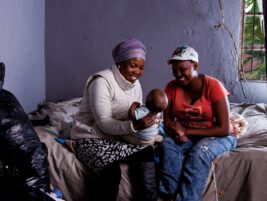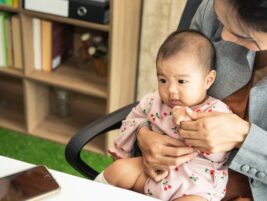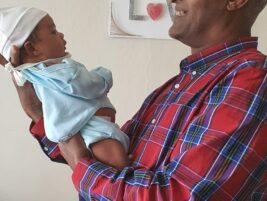An important way of demonstrating what is favourable or not to child development in terms of family functioning, is to combine research and clinical intervention. By doing so clinical practice becomes an object of research and conversely research brings useful results and tools to clinical practice.
Towards this aim, we have developed consultations known as “systems consultations” during which semi-structured situations are used that allow an evaluation with a therapeutic aim (using video-feedback and other methods tested in family clinical practice) whilst collecting data for research evaluation. Family interactions are video-recorded and can be microor macro-analysed subsequently, depending on the needs.
Systems consultation
Description of systems consultation
Systems consultation consists of family functioning assessment consultations, usually over two sessions, at the family’s request or that of a therapist. During the first session, the family, the therapist (if there is a network around the family, it is the maximum of people from the network who are invited) and the consultants of our research unit meet. After a period of introduction that is of great importance in establishing the therapeutic alliance, the family gets involved in family games which are video recorded. Then the questions that led to the consultation are asked by the therapist and/or the family. For example, the therapist can put into words a question-request such as: does the child and the family’s condition require ambulatory treatment? At the second session, involving the same people, having studied the videos and identified the relevant resources as well as the problems, we show interactive sequences illustrative of the family’s resources and difficulties. Extracts of video footage are therefore viewed and discussed. The family members are invited to talk about their experiences during the games and/or spontaneously having seen themselves in the films. The consultants then give their answers to the questions they had been asked based on the images shown. Finally, the consultants work out, with the family members as well as with the therapist if there is one, a few ideas for the next steps as to overcome the difficulties expressed during the first session or revealed during the video replay. Finally, all the participants sign authorizations for the use they agree we may make of the videos (research and/or teachingtraining). Note, however, that in the case of a family which is involved in therapy, we deliberately stay unaware of their case records and possible pathologies to avoid biasing our evaluation.
Aims and principles
Our aims, for research as well as for clinical practice, are the observation and assessment of different aspects of communication within family:
- the family alliance, that is, how the family forms a team to execute a task, in this case playing together and creating moments of shared pleasure;
- intersubjective communication (or the sharing of internal states) which is inseparable from visible interactions, even if it is only inferred from the observed behaviour;
- the baby’s skills, especially in terms of communication,
- besides the game that is privileged through our scenarios, other functional domains, such as attachment, setting of limits, etc.
At this point we would like to specify the principles that we find essential in systems consultation. First of all, assessment is also an intervention; these are two inseparable aspects of consultation. Second, our assessment and thinking is based on observable behaviors as captured by the films. Third, establishment of a therapeutic or research alliance, depending on the circumstances, seems essential to us in order to allow the family to function at its best and consequently to identify its resources clearly. Fourth, we assess resources as much as problems since we establish the intervention, on the one hand, in recognition of the difficulties that the family expresses and, on the other, in identifying their resources. Fifth, video feedback, allowing the expression by the family members of their feelings when watching themselves at play, is essential so as to verify that our observations are valid in the subjects’ opinion. Finally, the signature of the authorization to use the films shows the families and the therapists both our ethical standards and our respect for them.
Situations of observation
Several situations are available that allow assessment of the family system at different stages (prenatal, one child, several children) and at the different ages of the child. Before describing these scenarios, let us point out that in addition to the family system as a whole, it is also often judicious to observe the dyads which form the family, be it the couple in a conflict discussion task as Weiss & al. (1975) conceived, or those made up by each parent with the child separately and, consequently, out of view of the other parent.
The Lausanne Trilogue Play and its adaptations
The Lausanne Trilogue Play is one of the situations that we developed to systematically observe the interactions between two parents and a baby. In this scenario, the parents and the baby, installed in a triangle at a distance promoting dialogue, are invited to play together as a family, as they usually would, following a script in four parts. First of all, one of the parents plays with the child while the other is simply present, then the parents reverse roles, then the three of them play together and, finally, it is the child who is in the position of participant-observer in front of his parents who are talking to each other. So this script allows the exploration of all the possible threesome configurations (Fivaz-Depeursinge & Corboz-Warnery, 1999).
While keeping the play structure in several parts, the LTP can be adjusted to the child’s development: toys or objects (such as socks and little spoons) can be introduced, the child’s seat will be different depending on postural development (baby’s seat, high chair then normal chair), the instructions can include narrative elements from the age of four, and so on (Favez et al., 2006). The LTP can also be adjusted to families including more than one child. The script is the same: one parent plays with the siblings while the other one is participant-observer, the parents reverse their roles, the family members play all together, finally the children play while their parents talk. The families receive toys (as many lions, ducks and telephones as family members).
The LTP was also adjusted to the prenatal stage, asking the expectant parents to enact their first encounter, as they imagine it, with their baby after the birth (Caneiro and al., 2006).
The triadic games are assessed with the help of a macroanalytic coding system, the FAAS (Family Alliance Assessment Scales, unpublished manual), bearing on the following dimensions: participation, role organisation, focussing, warmth and affective contact, communication errors and their resolution, co-parental coordination and finally the child’s involvement.
The Picnic Game (PNG)
To complement the LTP, we have conceived a less structured scenario closer to daily life: the Picnic Game. Meals represent a window for the observation and assessment of family interactions, sometimes used in clinical practice. However, filming meals at home turns out to be costly in time and resources. Moreover, the variability of meal contexts (space at disposal, length of the meals, points of view, etc.) makes comparisons between families difficult, and cannot guarantee sufficient controls for using these situations for research purposes. To compensate for these two pitfalls, we conceived the PNG (Frascarolo & Favez, 2005), a scenario in which the family is asked to pretend having a picnic.
This situation permits appreciation of the family’s capacity to play for fun (implicit aim of the game), to be creative, to modify constraints such as the quantity of food that the children have to “eat” and their good manners. However it relates to daily life situations such as setting the table, tidying up at the end, leading the children to respect the spatial limits defined for the game, etc. The two aspects “game” and “daily reality” are complementary and make the observations all the more rich.
On a carpet of 4 by 4 metres (or less depending on the space at disposal), delimiting the space they can use, the family has at its disposal a bench, a table, chairs, toys and a toy tea set. The instructions invite them to pretend play at a picnic during about a quarter of an hour and to tidy up when they are finished.
This situation, videotaped in its entirety, can be used with any family with no restriction of age nor of the number of people (including babies as well as grand-parents).
The game is assessed with the RePAS (Revised Picnic Assessment Scale, unpublished manual), composed of the nine following dimensions: participation, (inclusion of the participants), allocation of leadership, structuring of the task and transitions, richness and fluidity of the configurations, co-parenting, marital exchanges, limit setting, family warmth and finally autonomy of the child(ren) sub-system.
Note that the situations used, such as the Lausanne Trilogue Play, the Lausanne Family Play and the Picnic Game, permit assessment not only of global family functioning but also of sub-systems’, in particular coparenting, axis of the family (McHale, 2007). Certain aspects of the marital system are also observable, as are the relationship of each parent to the child or children and sibling relationships within the family.
Clinical illustration
The family presented here is made up of three children (two boys, respectively 7 and 5 years old and a 2 and a half year-old girl). The parents spontaneously asked for a consultation because they were concerned about the position of the middle child who harassed his parents with questions and was difficult to please. The question that they asked themselves was: does each child, and in particular the middle child, have his own place in the family?
We asked them to perform the Lausanne Family Play and the PNG and it is the contribution of this latter to the understanding of their family dynamics that we will outline.
Description of the game
The boys take their bags enthusiastically to go on the picnic in contrast with the daughter who shows herself to be grumpy. Having taken a few steps, the parents announce that they have arrived at the picnic place. The father and then the mother invite the little one to take her bag that the father has been carrying. For a while, everyone investigates the toys contained in the children’s bags. When the little one steps off of the carpet for a moment, the mother invites her to come back in and the father insists. She leaves again and this time it is the older brother who tells her to come back, and the two parents confirm.
Then the parents go to set the table, with the girl’s help, while the boys are playing. This done, the boys are invited to come to the table. The mother says “have a nice meal” several times, but it is not repeated by the others. The father invites them to say “cheers” and says “cheers” to everyone; the parents exchange a smile of complicity and the mother also says “cheers” to the children. The two parents agree to refuse the first time the younger boy asks to leave the table, but accept when the older one also wants to go to play. The time of the meal is very short (a bit less than two minutes) and they do not say what they are eating. The parents stay at the table with the youngest child for a while. The younger son calls them out several times to show them things. Then the parents tidy up the dishes and go and sit beside each other on the bench. On several occasions, their movements are synchronised and their postures similar. The father suggests to the younger son playing with the little one. The mother repeats the request but the girl answers that she does not want to. The parents show that they are available, but do not play. The oldest one plays on his own but is not (self) excluded. The younger son seeks out his parents frequently to show them things. At one point, the parents look at each other and exchange smiles. The mother finishes this moment of complicity by kissing her daughter’s hair.
The oldest child says he wants to perform a pirouette which the mother refuses. But the father not seeing any reason to refuse, she agrees. So the boy does it watched by his father who encourages him.
After a while, the father signals the end of the picnic and the mother supports him. The younger son does not want to finish but the mother disputes with him. The father goes and helps him tidy up his toys but respects his desire to do that by himself. When everything is in order, they pretend to leave.
Analysis
The resources that we have pointed out are the following:
- the parents support and validate each other mutually in their role as parents. They can, therefore, count on an active and supporting co-parenting (see how they set the table and tidy up together and the episode where the two parents ask the little one to come back into the field of vision).
- they set a clear framework within which the children can demonstrate independence (they show interest in what the children are doing and answer their solicitations and questions; they repeat the rules related to the scenario and the rules of politeness such as the use of “please”, etc.)
- they do their utmost to put in place rituals (“cheers”, “have a nice meal”), useful in strengthening family links.
Regarding the respective places in the family of the children, the oldest one seems very well-behaved and reasonable. He is self-sufficient, but takes an interest in what is happening around him (for example, he reminds his sister not go beyond the carpet).
As for the middle child, he creates linkages within the family. Indeed, by asking questions and showing things to his parents, not only does he establish his place in the family, but he also creates connexions between all of them by attracting their attention. As for the youngest child, she shows independence without necessarily excluding herself. She knows how to oppose (refusal of the bag at the beginning and of the suggestion that she play with the younger brother) and she also knows how to “feel good” with the others (as when she goes to sit between her parents on the bench).
We identified one difficulty in this family’s functioning, namely that by wanting to secure each one’s own place in the family too much, it is perhaps the family as a whole that suffers. The parents, always available and ready to answer everyone’s needs, create few moments of shared exchanges between all of them (for example, the failure of the “have a nice meal” of mother because father was taking care of the boys; or the “cheers” which occur in a series of two-way “cheers” and not by including everyone at the same time). This absence of a common main interest or activity shared by all, prevents a real affective communion between them. This lack of affect sharing between all family members risks to hinder the development of a real sense of family and sibship.
Restitution
During the restitution the parents said that they clearly recognized their family in the video and that everyone behaved in a normal way.
First of all we underlined the parents’ skills, their willingness to do well and their success. To answer the question of everyone’s place in the family, we showed that the youngest child is already quite independent and that she knows how to occupy her place. We underlined that it is perhaps by his questions and solicitations, that the younger son occupies his place and that his way of doing things creates links between the family members. We invited the parents and the mother in particular, to see his rebellious behaviour in a positive way because, although they can be trying for the parents, it is also a way of establishing one’s place in the family. We pointed out that the oldest child is perhaps the one who is least demanding and that it is therefore important to validate what he does and says (as the father did with the pirouette). This remark touched the father by recalling his own history as an oldest child. We also told them about our concern over the position given to the couple and especially to the mother who is completely devoted to each of them. Her husband claimed to be pleased that we underlined that because it is also his own point of view. The mother was overcome by emotion.
We explained to the parents that we wondered whether by wanting to guarantee each individual his own place in the family, it was not finally the family as a whole that suffered and we showed them, as examples, the occasions where the parents say “have a nice meal” and “cheers”.
We concluded by asking the parents not to take the middle child’s behavior and especially his questions, against themselves but rather to see their positive side as reinforcement of links within the family. We underlined their qualities as parents and their motivation to do well and, this being so, we suggested they allow themselves more relaxation and pleasure, stressing in particular that the mother take care of herself (for example through a regular activity that she likes). Finally, we suggested activities in common such as family games.
Conclusion
We have given an outline of the usefulness of systems consultation in assessing family dynamics, not only from a research perspective but also for clinical or even therapeutic purposes.
Indeed on the one hand, by using semi-standardized situations for which coding systems exist, we can collect data for scientific studies (comparison between groups of families, longitudinal studies, study before a certain life event versus after it, or pre-/ post-therapy). On the other hand, by offering an insight into what family resources and difficulties may be in play activities resembling daily life, it gives a very useful point of view in clinical practice.
Systems consultation can therefore be a meeting ground of researchers and clinicians; to which each one, while maintaining his own objectives, can bring his skills and can be enriched of those of the others in a fruitful exchange. Finally, viewing the films with the family enables us to address certain difficulties or simply different aspects of family life such as limit setting, distribution of daily tasks, everyone’s place in the family, etc. Indeed the film is a preferred support in discussing family problems and resources. It is important to underline that, during the viewing, parents, like those of the family presented here, often indicate that their own behavior and that of their child(ren) are typical of their daily experience (for example, the child who sits for a long time at table, the marital couple’s selfeffacement in favour of the parentchild relationship, etc.).
References
Carneiro, C., Corboz-Warnery, A., & Fivaz-Depeursinge, E. (2006). The prenatal Lausanne trilogue play : A new observational assessment tool of the prenatal co-parenting alliance. Infant Mental Health Journal, 27, 207-228.
Favez, N., Frascarolo, F., Carneiro, C., Montfort, V., Corboz-Warnery, A. & Fivaz-Depeursinge, E. (2006). The development of the family alliance from pregnancy to toddlerhood and children outcomes at 18 months. Infant and Child Development, 15, 59-73.
Fivaz-Depeursinge, E., & Corboz-Warnery, A. (1999). The primary triangle. A developmental systems view of mothers, fathers, and infants. New York: Basic Books.
Frascarolo, F., & Favez, N. (2005). Une nouvelle situation pour évaluer le fonctionnement familial : Le Jeu du PiqueNique (A new situation to assess family functioning: the Picnic Game). Devenir, 17, 141-151.
McHale, James P. (2007). Charting the Bumpy Road of Coparenthood Understanding the Challenges of Family Life, Washington DC: Zero to three.
Systems consultation: a clinical tool joining up research and clinical practice
Authors
Frascarolo-Moutinot, France,
Favez, Nicolas,
USA








